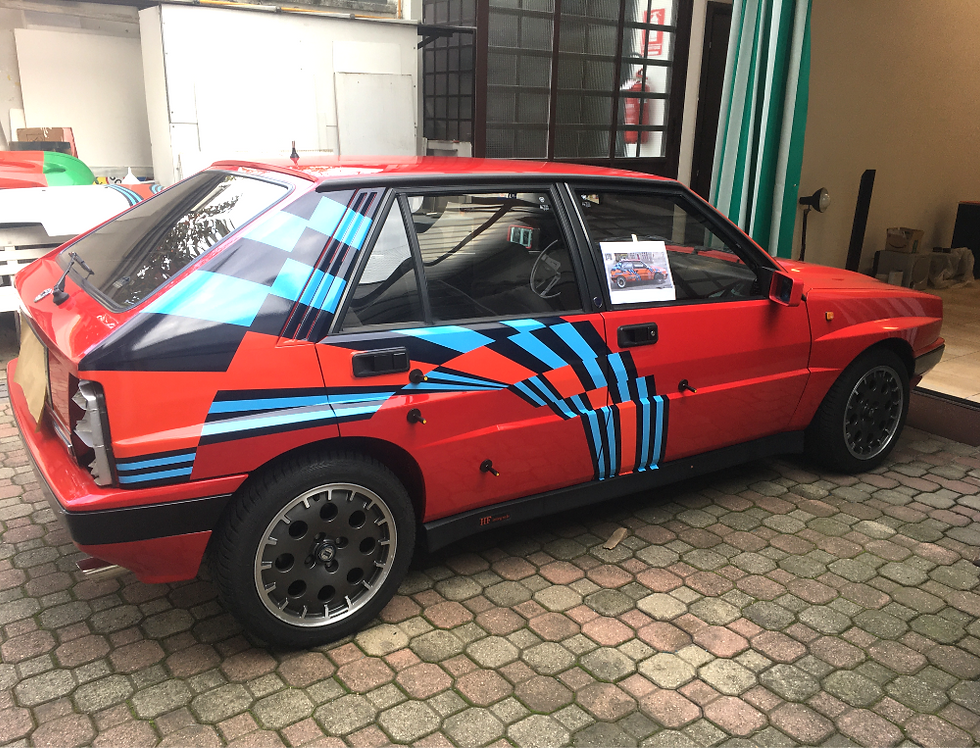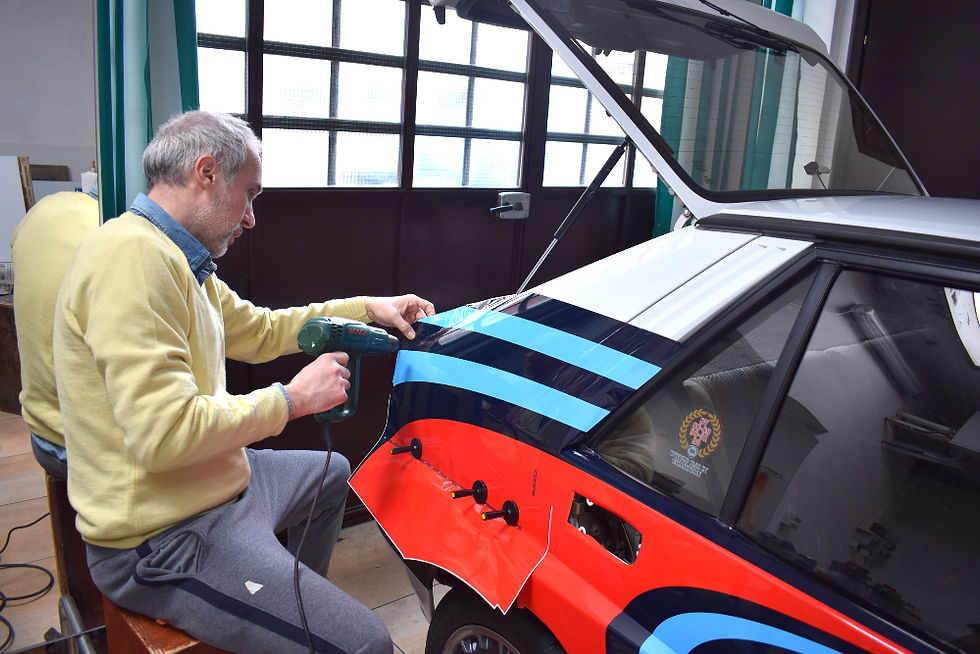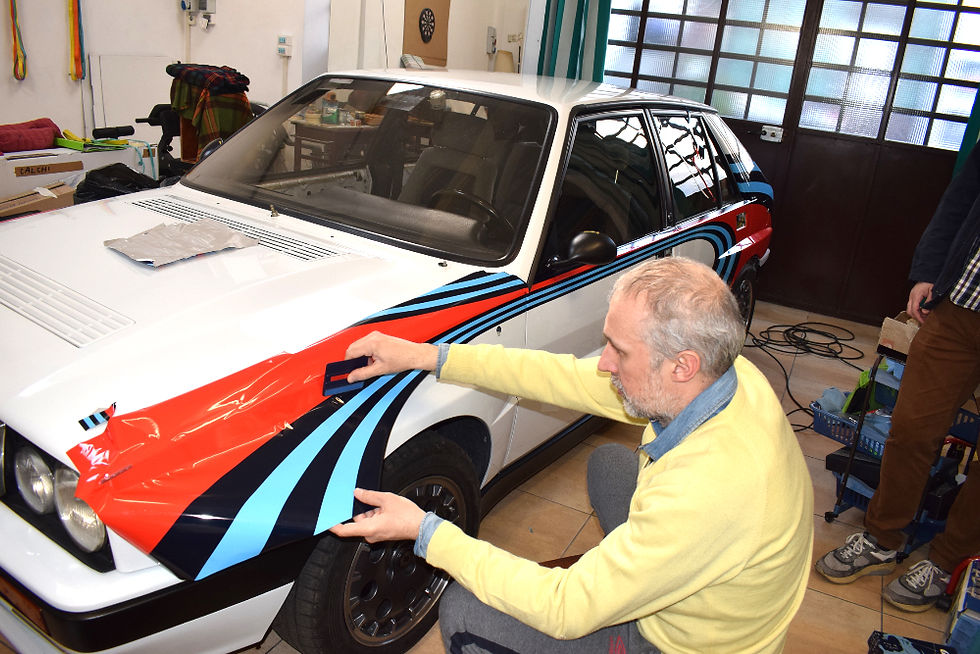Types of processing
Pubblimais created the original graphics for the Lancia, Fiat, and Abarth cars that participated in and won the World Rally Championship, and still reproduces these graphics on the cars of collectors and enthusiasts from all over the world.
Fiat, Abarth, and Lancia cars are famous not only for their countless victories but also for the colorful liveries that characterized them: Martini Racing, Fina, Totip, Grifone, Olio Fiat, Alitalia, Marlboro, Pirelli, Shell, and many others.
At the time, these liveries were done entirely in paint because the adhesive material was not yet sufficiently advanced and was only used for sponsors and lettering.
Thanks to its extensive experience in the field, Pubblimais has a unique wealth of knowledge in the field of historical graphics: the original livery colors, drawings and casts taken from original vehicles, a vast warehouse with original stickers from the period, and a huge historical photographic archive.
PAINT OR ADHESIVE?
Today, it's possible to replicate the historic rally graphics of Fiat, Abarth, and Lancia cars in two ways: paint and stickers . Let's explore the characteristics of each of these processes.
EXECUTION IN PAINT









The graphics of the historic livery are entirely painted like the original, using the same colors and painting methods as the original, further enhancing the car's authenticity. Only the sponsors are applied with stickers, except for some brands or lettering, which are painted like the originals (for example, the Alitalia lettering for the Alitalia livery or the Marlboro Lancia-Italia lettering on the Lancia Fulvia HF).
The liveries are not created with computerized templates, but through a manual process, hand-tracing all the graphic elements with tape for a non-artificial and non-replicable aesthetic, with a handcrafted feel: each graphic reproduction is unique. Even the rendering of the painted surfaces takes into account the historical period, so modern high-gloss finishes are not used where they weren't available at the time, and clear coat is not sprayed where it wasn't available.
The technical sponsors, brands and logos are made of the highest quality cast adhesive - with protective lamination against atmospheric agents and abrasions - to faithfully replicate the measurements and colours of the originals with the possibility of executing them in "vintage" mode for an effect that recalls screen printing and historic stickers.
Processing times depend on the car model and the chosen graphic version.
This creation is particularly suitable for the graphic reworking and restoration of ex-official and original cars of the period, intended for exhibitions and displays at car showrooms and prestigious fairs.
This workmanship is the most valuable and, among other things, gives the car a sort of "certificate" of authenticity as it is carried out by the same hands and the same company that created many of the historic graphics of the time.
ADHESIVE EXECUTION









All graphics, including the livery, are created entirely using decals. Since 2010, the historic liveries have been digitized and reconstructed using decals by Pubblimais with the utmost precision, both in terms of shape and color. For the decal liveries, we use high-quality, conformable cast adhesive vinyls, applied using a heat-curved method for extremely long durability, allowing for application even on all rounded and curved body parts, grilles, and air intakes. The livery features a very thin, high-gloss protective lamination that effectively reproduces a paint-like effect.
The technical sponsors, brands and logos are produced on top quality cast adhesive - with protective lamination against atmospheric agents and abrasions - to faithfully replicate the measurements and colours of the originals with the possibility of producing them in "vintage" mode for an effect that recalls screen printing and historic stickers.
This creation is particularly suitable for road or historic - but not official - cars that participate in revivals and historic rally competitions, for non-original cars that take part in historic car rallies organized by clubs, or for simple enthusiasts.
Thanks to modern technology, the complete adhesive application is aesthetically very similar to the paint application. Except in specific cases of historic, ex-official cars that necessarily require the paintwork to be restored to the original, this solution is highly recommended for everyone. It allows for a faithful and aesthetically excellent replica of the original, at a lower cost than paint work and with the possibility—in the event of a future sale of the car—of completely removing the livery without damaging the original paintwork.



